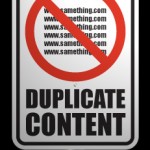 Duplicate content has become a hot issue in the SEO world and it can cause big problems for sites. Don’t be a duplicate content offender – use these best SEO practices to avoid duplication issues.
Duplicate content has become a hot issue in the SEO world and it can cause big problems for sites. Don’t be a duplicate content offender – use these best SEO practices to avoid duplication issues.
It’s very likely that another website could be passing off your content as their own, and you may not even know it! As a result, your site could be penalized as the violator for duplicated content and not picked up as the “original” expert source.
The worst thing that can happen is that your site is dropped from high-ranking search engines such as Google. Other issues: traffic dramatically decreases, ranks wrong page versions (page 2 instead of page 1), and low ranking for newly-launched sites.
Duplicate content is broken down into two categories: external and internal.
External
- Tricky “scrapper” sites troll the Internet searching sites for fresh content. They swipe YOUR content and pass it off as their original content. Your site gets banned because your site is recognized in search engines as duplicated content.
- If you find out that your content is used without permission, contact the webmaster and ask them to remove your content immediately.
- If you run into a webmaster that doesn’t budge, contact the search engine directly to report the duplicated content.
Internal
- Sites that sell products sometimes run into duplicated content issues, especially if they include multiple product descriptions on their web pages.
- Blogs are often notorious for duplicate content – this happens when identical content shows up on both the direct post URL and home page.
How Can You Check For Duplicate Content?
These free SEO tools can easily check sites for duplication issues.
- Copyscape – Searches for duplicated/plagiarized content
- Xenu – Scans site links and searches for identical URL titles
- Google Webmaster tools – Reports duplicate meta descriptions and titles
These tools check the following areas:
- Google cache
- 404 header response
- PR (PageRank) dispersion
- Default pages and similarity
- WWW and Non-WWW Headers
Take proactive steps to ensure your content isn’t duplicated
- Avoid empty web pages (placeholders) whenever possible
- Minimize similar content – merge similar pages or create unique content for each page
- Keep internal linking consistent
- Use only top-notch domains that are country-specific
- Carefully review webmaster guidelines (under Google Webmaster Tools)
- Understand how content is displayed (especially sites that show the same content on different pages such as forums and blogs)
How To Handle Illegal Copyright Issues
If webmasters or search engines don’t remove your plagiarized content from other sites, contact the web hosting company or domain registration company. If they host illegal copyrighted material, they violate their Terms of Service and DMCA regulations and could get into trouble.
These companies can’t take that risk, so they will usually pull off the plagiarized content immediately. In severe abuse cases with content violations, the owner of the copyrighted material/website can take action with the hosting or domain registration company to shut down the site permanently. You can’t afford to have your website shut down so don’t be a duplicate content offender!

